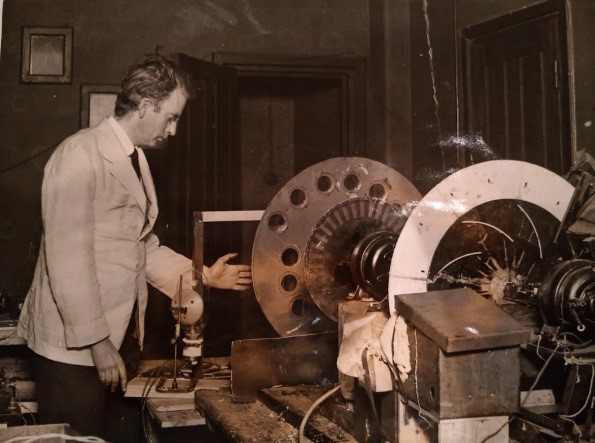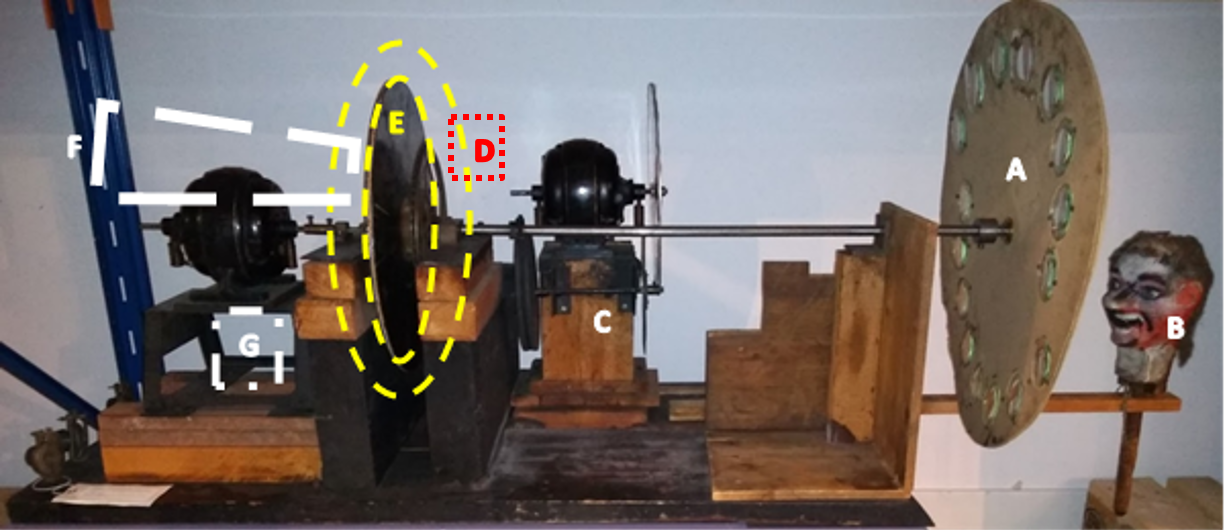One of the most enjoyable aspects of working with the National Science and Media Museum’s collections is helping researchers get access to some of the fascinating objects in our stores and being able to expand our knowledge of some of the more intriguing devices. The Baird Double 8 apparatus is one such device and, like many of Baird’s devices, its operation is shrouded in mystery. This is in part due to Baird’s concerns over commercial secrecy, but also his lack of documentation, especially on older work. Don McLean notes that
“throughout his life, [Baird] considered his next idea more important than documenting his current or previous ones.”[1]

As such there is little original documentation to explain the workings of his different devices, and historians have struggled to explain the nature and operation of his devices ever since. For many years Baird’s early experimental apparatus, with the somewhat terrifying ‘Stookie Bill’ as its test subject, has been viewed as the birth of television. However, the experimental nature of the device along with the fact that it is missing several components has made it difficult to understand how it would have worked.
Recent research by Don McLean suggests that this device was likely a single all-in-one demonstration unit, possibly used in one of the famous Selfridges demonstrations, with the image being created and viewed on the same device.

As it was originally configured, the device contained not one but two Nipkow discs. The first one at the front, which is still in existence, was used to scan the subject being viewed. The second disc, which appears to have been cut off before coming to the Science Museum, was used to display the image for the viewer.
The other components which appear to be missing are the photocell, the signal amplifier and the neon light tube for the display. Closer examination suggests that photocell, previously unlocated, was mounted in the wooden box beneath the foremost motor. Additional comparisons to contemporary photographs also reveal the likely locations of the missing Nipkow disc (E), neon lamp (D), signal amplifier (G) and viewing tube (F).
So how did it actually work?
- Bright hot studio lights lit Stookie Bill’s (B) face.
- The lens disc (A) swept the image of the dummy head point-by-point, line-by-line across the photocell.
- The photocell (C) converted the varying light value reflected from Stookie Bill’s face into an electrical signal.
- This was then amplified (G), and the signal was sent to a valve or neon tube (D) positioned behind the second Nipkow disc (E).
- The brightness of the neon lamp was varied in proportion to the brightness of each spot on the image.
- As each hole in the disk passed by, one scan line of the image was reproduced, gradually building up to the complete picture for the viewer (F).

The device seen here is from a very early period of Baird’s experimental work, during which he was only able show simple shapes without any surface detail or texture. This device was donated to the Science Museum in 1926, indicating that he had abandoned using the double-8 spiral of lenses in favour of a single 30-lens spiral. Indeed, it was this later 30-lens system which was used in his first demonstrations of 30-line television in January 1926.
So why is any of this important? We know that ultimately Baird’s approach was abandoned in favour of the Marconi/EMI electronic television system. However, the evidence for this having been used as a portable all-in-one demonstration unit further enhances the claim that while Baird may not have ‘invented’ TV as we know it today, his work and demonstrations raised awareness about the possibility of television as a medium for communication, education and entertainment.
[1] The Achievement of Television: the quality and features of John Logie Baird’s system in 1926, D F McLean, Intl J of Hist of Eng Tech, Vol 84 No 2, July 2014, 227-247 DOI: 10.1179/1758120614Z.00000000048, 229.
Paul hopefully you read this in time unfortunately I’ve already listed the item on eBay what I came across here in America is a 1934 BBC Marconi experimental condenser microphone I think it’s in the 1951 book of engineering or schematics for BBC or Marconi I’m not sure but I’m sure you I tried reaching someone at the museum I’ve tried everyone and Martin Mitchell directed me to try and speak to somebody at your museum but then again I’d already listed it on eBay it has 6 days left at the auction I cannot put from the auction and still keep my reputation as a seller it has a lot of bids already so if you’re interested in looking at it or if you want to email me for some photographs jeffro4226@gmail.com is my email. Unfortunately I can’t send photographs here please contact me ASAP